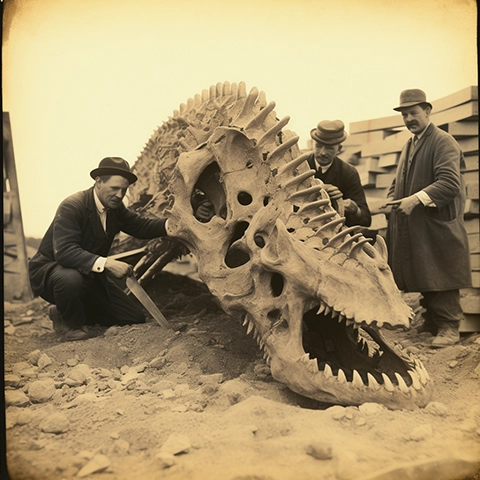The early 1900s witnessed a perplexing enigma in the heart of a desolate desert, an enigma that continues to bewilder scientists and enthusiasts alike. This was the discovery of a mysterious skeleton, unlike any seen before, which ignited intrigue, speculation, and ultimately became known as the ‘Desert Dragon Skeleton’ – a tale that remains shrouded in mystery.
The story began in the early 1900s, in the vast expanse of a remote desert, far from the bustling scientific communities of the time. Two intrepid paleontologists, Dr. Eleanor Foster and Dr. Victor Williamson, embarked on an ambitious expedition to uncover the secrets of this arid wasteland. It was there that they made a discovery that would send shockwaves through the scientific community.
The skeleton they unearthed was unlike anything they had ever encountered in the barren dunes. Its sheer size and peculiar bone structure defied all conventional wisdom about prehistoric creatures. The fossil was remarkably well-preserved, with bones that were both fragile and strangely robust, and teeth that appeared almost reptilian but undeniably massive. The head was long and extended, bearing an uncanny resemblance to the depictions of dragons in folklore.
As word of the discovery spread, the scientific world was divided. Many experts dismissed the skeleton as a mere anomaly or hoax, believing that no creature of such a magnitude and distinct morphology could ever have existed in the scorching desert. Skeptics argued that the unusual appearance of the skeleton was likely due to a combination of geological forces, rather than a testament to a prehistoric creature.
Nonetheless, Foster and Williamson were determined to find answers and continued their meticulous examination. They sought the counsel of renowned paleontologists and anatomists, but the conclusions remained elusive. There was a financial burden too, as storing the colossal skeleton required considerable resources. However, the mystery was far too compelling for the two dedicated researchers to give up. They were resolute in their quest for the truth.
In the ensuing years, Foster and Williamson approached museums and institutions with their extraordinary discovery, hoping to secure funding and a place to exhibit the skeleton. However, they were met with skepticism and reluctance at every turn. Museums were reluctant to invest in what they considered a dubious artifact, and the scientific community largely remained unconvinced.
As the financial burden grew and the animosity of the scientific community persisted, Foster and Williamson reluctantly made the heart-wrenching decision to dispose of the skeleton, leaving the enigmatic creature’s origin unconfirmed. The dragon-like fossil, which had once promised to rewrite history, was relegated to obscurity and lost to the shifting sands of time.
Over the years, the legend of the “Desert Dragon Skeleton” persisted, and speculation ran wild. Some believed it was the remains of a prehistoric dragon, a creature straight out of myth and folklore. Others considered it a peculiar hybrid or an undiscovered species. The truth, however, remains locked away, an enduring mystery that continues to captivate the imagination of those who dare to ponder it.
In the world of paleontology, the enigmatic case of the unidentified skeleton discovered by Dr. Eleanor Foster and Dr. Victor Williamson in the early 1900s remains a testament to the boundless mysteries of our planet’s history. The story of the dragon-like fossil serves as a poignant reminder of how even the most groundbreaking discoveries can fade into obscurity, awaiting the day when science might finally reveal their secrets. Until then, the “Desert Dragon Skeleton” remains a tantalizing riddle, forever hidden in the shifting sands of time, an enduring symbol of the mysteries that still lie buried beneath the desert’s surface.

